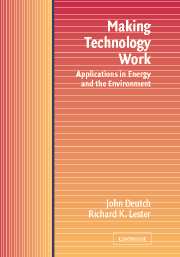Book contents
- Frontmatter
- Contents
- Preface
- 1 Introduction
- 2 Gasohol
- 3 Solar Thermal, Windpower, and Photovoltaic Technologies
- 4 Electricity from Coal
- 5 Controlling Acid Rain from Coal-fired Power Plants
- 6 Greenhouse Gases and Global Warming
- 7 Nuclear Power and Its Fuel Cycle
- 8 Managing Nuclear Waste
- 9 Nuclear Power and Weapons Proliferation
- 10 Natural Gas
- 11 Safety and Risk: Examples from the Liquefied Natural Gas and Nuclear Industries
- 12 Synthetic Fuels
- 13 Fuel Cells For Automobiles
- 14 Energy Models and Statistics
- 15 The Government's Role in Innovation
- 16 Conclusions
- Index
8 - Managing Nuclear Waste
Published online by Cambridge University Press: 10 December 2009
- Frontmatter
- Contents
- Preface
- 1 Introduction
- 2 Gasohol
- 3 Solar Thermal, Windpower, and Photovoltaic Technologies
- 4 Electricity from Coal
- 5 Controlling Acid Rain from Coal-fired Power Plants
- 6 Greenhouse Gases and Global Warming
- 7 Nuclear Power and Its Fuel Cycle
- 8 Managing Nuclear Waste
- 9 Nuclear Power and Weapons Proliferation
- 10 Natural Gas
- 11 Safety and Risk: Examples from the Liquefied Natural Gas and Nuclear Industries
- 12 Synthetic Fuels
- 13 Fuel Cells For Automobiles
- 14 Energy Models and Statistics
- 15 The Government's Role in Innovation
- 16 Conclusions
- Index
Summary
The management and disposal of radioactive waste from the nuclear fuel cycle is one of the most intractable problems facing the nuclear power industry around the world. Today, more than forty years after the first nuclear power plant entered service, no country has yet succeeded in disposing of high-level nuclear waste – the longest-lived, most highly radioactive, and most technologically challenging of the waste streams generated by the nuclear industry. Most countries have stated their intention to dispose of the waste in repositories constructed in rock formations hundreds of meters below the earth's surface. But no country has actually put a geological repository for high-level waste into service, and all have encountered difficulties with their programs. The problems are partly technological and partly political, and it is impossible to draw a sharp line between them.
The basic policy questions in the field of high-level nuclear waste – What is to be done? Who should decide? Who should pay? Who will implement the solution? – are questions encountered in many other fields of technology. In this case, however, their resolution is made more difficult by several factors, including the very hazardous nature of the waste itself, the extremely long time for which it must be contained, and the special fear that it evokes among many people as a result of these characteristics and the disturbing presence of nuclear radiation.
- Type
- Chapter
- Information
- Making Technology WorkApplications in Energy and the Environment, pp. 134 - 153Publisher: Cambridge University PressPrint publication year: 2003



